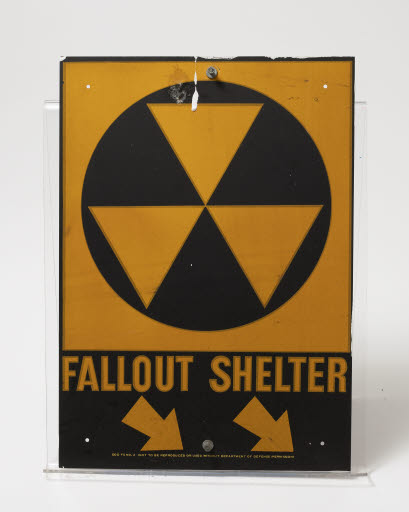Collections
| Back New Search Tips |
Fallout Shelter Sign

|
| Accession #: | 3719.1 |
|---|---|
| Title: | Fallout Shelter Sign |
| Object Type: | Sign |
| Participants: | |
| Physical Description: | Metal with unpainted back. Front painted: yellow square enclosing black circle that encloses three yellow triangles. Under the yellow square are the words "Fallout Shelter" and two arrows slanting down; all in yellow on black background. Inscribed at bottom: Four small holes in each corner and two screws in the center of the sign both top and bottom. Some drops of white paint around the edges and center of sign, and ground-in dirt overall. |
| Description: | In the fall of 1961, the federal Office of Civil Defense started a Community Fallout Shelter Program across the United States, an enormous underground network to shelter the population from radiation in case of nuclear war. Standardized signs designated buildings with public fallout shelters. Those taking shelter would find radiation detection instruments, sanitation supplies, and for each individual, a daily quart of water and 700 calories of food, for up to a 2- week stay. When federal funding for supplies stopped in the mid-1960s community shelters were slowly discontinued over the next decade. With USA and USSR as lead protagonists, the Cold War existed with various points of high tension from 1945 to 1991. Threats of nuclear war drew intercontinental missiles to the Inland Northwest, hidden in underground silos and ready for immediate launch. Nike Ajax surface-to-air missiles guarded Fairchild Air Force Base during the Cold War, while the Moses Lake Air Base was reactivated in the 1950s as a Strategic Air Command location to protect Grand Coulee Dam and the Hanford Atomic Works. Each community made plans for civil defense, including numerous community fallout shelters and a siren to warn citizens should a nuclear attack commence. School children took part in regular drills and some families built underground bomb shelters in basements and yards. As the nuclear threat diminished, the missile silos were shuttered or sold for new uses, like equipment storage and even club meeting halls. Sources: Hometowns: Heart of the Inland Northwest (December 5, 2001 - June 20, 2004), Northwest Museum of Arts & Culture, Spokane. http://www.civildefensemuseum.com/index.html (Accessed July 2010). http://www.fcgov.com/oem/civildefense.php (Accessed July 2010). Reinartz, Kay F. The Inland Northwest: A Modern History of a Dynamic Region. Carlsbad: Heritage Media Corp., 2002. |
| Category: | History |
| Dimensions: |
Object H x W 14 x 10"
|
| Materials/Techniques: |
paint (Material)
metal (Material)
|
| Marks/Inscription: |
Located at the bottom of the sign, "DOD FS NO.2 (NOT TO BE REPRODUCED OR USED WITHOUT DEPARTMENT OF DEFENSE PERMISSION)"
|
| Related Exhibits: | |
| Credit Line: | Gift of Mr. Robert Emacio |
To order a reproduction, inquire about permissions, or for information about prices see:
https://www.northwestmuseum.org/collections